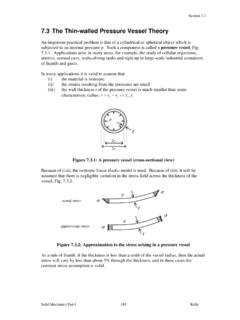Transcription of 6 ANATOMY OF F P - NCERT
1 84 BIOLOGY. C HAPTER 6. ANATOMY OF FLOWERING PLANTS. The Tissues You can very easily see the structural similarities and variations in the external morphology of the larger living organism, both plants and The Tissue animals. Similarly, if we were to study the internal structure, one also System finds several similarities as well as differences. This chapter introduces ANATOMY of you to the internal structure and functional organisation of higher plants. Dicotyledonous Study of internal structure of plants is called ANATOMY . Plants have cells and as the basic unit, cells are organised into tissues and in turn the tissues Monocotyledonous are organised into organs.
2 Different organs in a plant show differences in Plants their internal structure. Within angiosperms, the monocots and dicots are also seen to be anatomically different. Internal structures also show Secondary adaptations to diverse environments. Growth THE TISSUES. A tissue is a group of cells having a common origin and usually performing a common function. A plant is made up of different kinds of tissues. Tissues are classified into two main groups, namely, meristematic and permanent tissues based on whether the cells being formed are capable of dividing or not. Meristematic Tissues Growth in plants is largely restricted to specialised regions of active cell division called meristems (Gk.)
3 Meristos: divided). Plants have different kinds of meristems. The meristems which occur at the tips of roots and shoots and produce primary tissues are called apical meristems (Figure ). 2021-22. ANATOMY OF FLOWERING PLANTS 85. Central cylinder Cortex Leaf primordium Protoderm Shoot apical Meristematic zone Initials of central cylinder Root apical Axillary bud and cortex meristem Differentiating Initials of vascular tissue root cap Root cap Figure Apical meristem: (a) Root (b) Shoot Root apical meristem occupies the tip of a root while the shoot apical meristem occupies the distant most region of the stem axis.
4 During the formation of leaves and elongation of stem, some cells left behind' from shoot apical meristem, constitute the axillary bud. Such buds are present in the axils of leaves and are capable of forming a branch or a flower. The meristem which occurs between mature tissues is known as intercalary meristem. They occur in grasses and regenerate parts removed by the grazing herbivores. Both apical meristems and intercalary meristems are primary meristems because they appear early in life of a plant and contribute to the formation of the primary plant body. The meristem that occurs in the mature regions of roots and shoots of many plants, particularly those that produce woody axis and appear later than primary meristem is called the secondary or lateral meristem.
5 They are cylindrical meristems. Fascicular vascular cambium, interfascicular cambium and cork-cambium are examples of lateral meristems. These are responsible for producing the secondary tissues. Following divisions of cells in both primary and as well as secondary meristems, the newly formed cells become structurally and functionally specialised and lose the ability to divide. Such cells are termed permanent or mature cells and constitute the permanent tissues. During the formation of the primary plant body, specific regions of the apical meristem produce dermal tissues, ground tissues and vascular tissues. 2021-22.
6 86 BIOLOGY. Permanent Tissues The cells of the permanent tissues do not generally divide further. Permanent tissues having all cells similar in structure and function are called simple tissues. Permanent tissues having many different types of cells are called complex tissues. Intercelluar space Simple Tissues A simple tissue is made of only one type of cells. The various simple tissues in plants are parenchyma, collenchyma and sclerenchyma (Figure ). Parenchyma forms the major (a) component within organs. The cells of the parenchyma are generally isodiametric. They Thickened corners may be spherical, oval, round, polygonal or Protoplasm elongated in shape.
7 Their walls are thin and made Vacuole up of cellulose. They may either be closely packed Cell wall or have small intercellular spaces. The parenchyma performs various functions like photosynthesis, storage, secretion. The collenchyma occurs in layers below the epidermis in most of the dicotyledonous plants. It is found either as a homogeneous layer or in patches. (b) It consists of cells which are much thickened at the corners due to a deposition of cellulose, hemicellulose and pectin. Collenchymatous cells may be oval, spherical or polygonal and often Pits Lumen contain chloroplasts. These cells assimilate food Thick when they contain chloroplasts.
8 Intercellular spaces cell wall are absent. They provide mechanical support to the Lumen growing parts of the plant such as young stem and Thick petiole of a leaf. cell wall Sclerenchyma consists of long, narrow cells A sclereid with thick and lignified cell walls having a few or A fibre numerous pits. They are usually dead and without (c) protoplasts. On the basis of variation in form, structure, origin and development, sclerenchyma Figure Simple tissues : (a) Parenchyma may be either fibres or sclereids. The fibres are (b) Collenchyma thick- walled , elongated and pointed cells, (c) Sclerenchyma generally occuring in groups, in various parts of the plant.
9 The sclereids are spherical, oval or cylindrical, highly thickened dead cells with very 2021-22. ANATOMY OF FLOWERING PLANTS 87. narrow cavities (lumen). These are commonly found in the fruit walls of nuts; pulp of fruits like guava, pear and sapota; seed coats of legumes and leaves of tea. Sclerenchyma provides mechanical support to organs. Complex Tissues Tracheid Vessels The complex tissues are made of more than one type of cells and these work together as a unit. Xylem and phloem constitute the complex tissues in plants (Figure ). Xylem functions as a conducting tissue for water and minerals from roots to the stem and leaves.
10 It also provides mechanical strength to the plant parts. It is composed of four different kinds of elements, namely, tracheids, vessels, xylem fibres and xylem parenchyma. Gymnosperms lack vessels in their xylem. Tracheids are elongated or tube like cells with thick and lignified walls and tapering ends. These are dead and are without protoplasm. The inner layers of the cell walls have thickenings which vary in form. In flowering plants, tracheids and vessels are the main water transporting elements. vessel is a long cylindrical tube-like structure made up of many cells called vessel members, each with lignified walls and a large (a).














